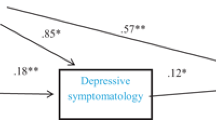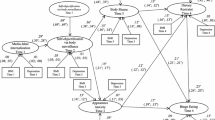Abstract
Background
This study examined this relationship between eating disordered behaviors and exposure to ideal-type media in a sample of South African university students, who could be expected to have reasonably high levels of media exposure. Possible underlying reasons for this complex relationship were also investigated.
Method
It examined the relationship via both quantitative (using a questionnaire that included the EAT-26 and a media composite variable) and qualitative methods (interviews) in the sample.
Results
In the quantitative part, sex and level of media exposure significantly predicted scores on the EAT-26. Women obtained scores that indicated they were more “at risk” for anorexia nervosa than men, especially women with higher levels of media exposure. In the qualitative part of the study grounded theory was used to explore how this relationship was formed. Results indicated that numerous factors, some related to the media, predispose women to disordered eating behaviors. The interviewees were then more likely to use ideal-type media heavily to sustain their disordered eating behaviors. Heavy use of the media led participants to attempt a number of strategies to change their appearance to resemble those in the media, with various degrees of success.
Conclusion
The model developed by the qualitative research indicated that the media are not necessarily always the cause of pathological eating, but that they interact with other factors in the development of symptoms of anorexia nervosa for these women.
Similar content being viewed by others
Notes
In South Africa, the old “racial” categories of Apartheid are still used to monitor the implementation of employee equity policies, for example. We use the categories (black for black Africans, mixed-race for people previously classified as “colored”, Asian for “Asian”, and white for Caucasians) as a broad indicator of ethnic origin.
References
Becker AE, Burwell RA, Gilman SE, Herzog DB, Hamburg P (2002) Eating behaviors and attitudes following prolonged exposure to television among ethnic Fijian adolescent girls. Am J Psychiatry 180:509–514
Thomsen SR, McCoy JK, Williams M (2001) Internalizing the impossible: anorexic outpatients’ experiences with women’s beauty and fashion magazines. Eat Disord J Treat Prev 9(1):49–64
David P, Johnson MA (1998) The role of self in third person effects about body image. J Commun 48(4):37–58
Hawkins N (2000) The impact of the ideal thin body image on women. Dissertation Abstracts International, Section B: The Sciences and Engineering 60(11B):5835
Pinhas L, Toner BB, Ali A, Garfinkel PE, Stuckless N (1999) The effects of the ideal of female beauty on mood and body satisfaction. Int J Eat Disord 25(2):223–226
Hamilton K, Waller G (1993) Media influences on body size estimation in anorexia and bulimia: an experimental study. Br J Psychiatry 162:837–840
King N, Touyz S, Charles M (2000) Effects of body dissatisfaction on women’s perceptions of female celebrities. Int J Eat Disord 27(3):341–347
Coolican CR (2000) The effect of television programming that emphasizes beauty/thinness on women’s body image and self-esteem. Dissertation Abstracts International, Section A: Humanities and Social Sciences 61(3A):894
Harrison K, Cantor J (1997) The relationship between media consumption and eating disorders. J Commun 47(1):40–67
Myers PN, Biocca FA (1992) The elastic body image: the effect of television advertising and programming on body image distortions in young women. J Commun 42(3):108–133
Tiggemann M, Pickering AS (1996) Role of television in adolescent women’s body dissatisfaction and drive for thinness. Int J Eat Disord 20:199–203
Botta RA (2000) The mirror of television: a comparison of black and white adolescents’ body image. J Commun 50(3): 144–159
Heinberg LJ, Thompson JK (1995) Body image and televized images of thinness and attractiveness: a controlled laboratory investigation. J Soc Clin Psychol 14(4):325–338
Hill A (2001, August 12) Girls in danger as anorexics give weight loss tips on web. The Guardian Unlimited Observer [Serial Online] [cited 2002 May 16] Available from http://www.searchguardian.co.uk
Dias K (2003) The ana sanctuary: women’s pro-anorexia narratives in cyberspace. Int J Women’s Studies [Serial Online] [cited 2003 Sep 19]; 4(2):e31
Rothman-Morris B (2002) A disturbing growth industry: web sites that espouse anorexia. NY Times [Serial Online]. [cited 2003 Aug 21] June 23. Available from http://www.nytimesarticle.htm
http://www.voy.com. Cited 2003 Aug 22
Dunn I (2003, Aug) The body becomes paramount: Pro-ana groups in cyberspace. Paper presented at the Interface: Cutting-Edge Research Global Conference on: “Visions of Humanity in Cyberculture, Cyberpunk and Science Fiction”, Prague, Czech Republic [cited 2003 Aug 22]. Available from http://www.visions of humanity in cyberculture, cyberpunk and science fiction-session 6.htm
Hellmich N (2001, Jul 24) On the web: thinness worship. USA Today [Serial Online]. [cited 2002 May26]. Available from http://www.usatoday.com
American Psychiatric Association (1994) Diagnostic and statistical manual of mental disorders, 4th edn., revised. APA, Washington, DC
Gordon RA (1990) Eating disorders: anatomy of a social epidemic, 2nd edn. Blackwell Publishers, London
Casper RC, Offer D (1990) Weight and dieting concerns in adolescents, fashion or symptom? Pediatrics 86(3):384–390
Anderson AE, DiDomenico L (1992) Diet vs shape content in popular male and female magazines: a dose–response relationship to the incidence of eating disorders. Int J Eat Disord 11:283–287
Malkin AR, Warnian K, Chrisler JC (1999) Women and weight: gendered messages on magazine covers. Sex Roles 40(7–8):647–655
Dulce MJ, Hunter GC, Lozzi BM (1999) Do Cuban American women suffer from eating disorders? Effects of media exposure and acculturation. Hisp J Behav Sci 21(2):212–218
Tiggemann M, Ruutel E (2001) A cross-cultural comparison of body dissatisfaction in Estonian and Australian young adults and its relationship with media exposure. J Cross Cult Psychol 32(6):736–742
Strauss A, Corbin J (1998) Basics of qualitative research: grounded theory procedures and techniques. Sage Publications, Thousand Oaks, CA
Garner DM, Olmstead MP, Bohr Y, Garfinkel PE (1982) The eating attitudes test: psychometric features and clinical correlates. Psychol Med 12:871–878
Flick U (2002) An introduction to qualitative research. Sage Publications, London
Wade TJ, DiMaria C (2003) Weight halo effects: individual differences in perceived life success as a function of women’s race and weight. Sex Roles 48(9–10):461–465
Harrison K (2000b) Television viewing, fat stereotyping, body shape standards, and eating disorder symptomatology in grade school children. Commun Res 27(5):617–640
Fouts G (2000) Television situation comedies: female weight, male negative comments and audience reactions. Sex Roles 42(9–10):925–932
Reed RL (1999) Image and attitude: the impact of media images on the self-esteem, body image and sexual attitudes of college students. Dissertation Abstracts International, Section B: The Sciences and Engineering 59(8B):4542
Crowley JJ (1999) Media influence and the social self: the relation of other awareness to body image and eating pathology. Dissertation Abstracts International, Section B: The Sciences and Engineering 60(2B):867
Field AE, Cheung L, Wolf AM, Herzog DB, Gortmaker L, Colditz GA (1999) Exposure to the mass media and weight concerns among girls. Pediatrics [Serial Online]. [Cited 2003 September 19] 103(3):e36
Irving LM (1990) Mirror images: effects of the standard of beauty on the self- and body-esteem of women exhibiting varying levels of bulimic symptoms. J Soc Clin Psychol 9(2):230–242
Wegner BS, Hartmann AM, Geist CR (2000) Effect of exposure to photographs of thin models on self-consciousness in female college students. Psychol Rep 86:1149–1154
Stice E, Shaw HE (1994) Adverse effects of the media portrayed thin-ideal on women and linkages to bulimic symptomatology. J Soc Clin Psychol 13(3):288–308
Harrison K (2000a) The body electric: thin-ideal media and eating disorders in adolescents. J Commun 50(3):119–143
Le Grange D, Louw J, Breen A, Katzman MA (2004) The meaning of ‘self-starvation’ in impoverished black adolescents in South Africa. Cult Med Psychiatry 28(4):439–461
Wassenaar D, le Grange D, Winship D, Lachenicht L (2000) The prevalence of eating disorder pathology in a cross-ethnic population of female students in South Africa. Eur Eat Disord Rev 8:225–236
Acknowledgements
This material is based on work supported by the National Research Foundation of South Africa. Any opinion, findings and conclusions or recommendations expressed in this material are those of the authors and do not necessarily reflect the views of the Foundation.
Author information
Authors and Affiliations
Corresponding author
Rights and permissions
About this article
Cite this article
Carney, T., Louw, J. Eating disordered behaviors and media exposure. Soc Psychiat Epidemiol 41, 957–966 (2006). https://doi.org/10.1007/s00127-006-0120-9
Accepted:
Published:
Issue Date:
DOI: https://doi.org/10.1007/s00127-006-0120-9




